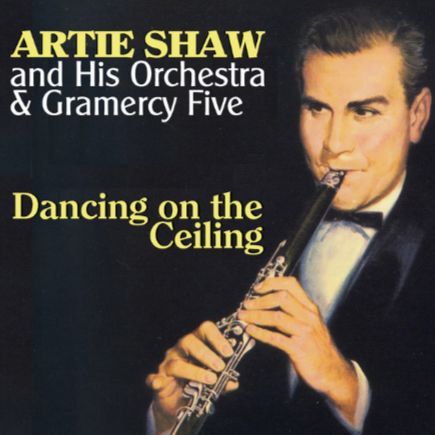They Can’t Take That Away From Me: entre swing élégant et émotion retenue
Écrite en 1937 par George Gershwin, avec des paroles de son frère Ira, They Can’t Take That Away From Me fait son entrée dans le film Shall We Dance, (L’entreprenant Monsieur Petrov), interprétée par Fred Astaire. Peu après, la mort prématurée de George confère au morceau une résonance particulière, comme une élégie discrète à l’amour et à la mémoire.
Musicalement, la chanson repose sur une structure en 32 mesures, typique du Great American Songbook, avec une mélodie tout en finesse qui épouse la diction du texte. Ce dernier égrène les souvenirs d’un amour passé, mais sans rancœur ni pathos: ‘The way you wear your hat / The way you sip your tea…’ (La façon dont tu portes ton chapeau / La façon dont tu sirotes ton thé…). Autant de détails intimes et singuliers, érigés en rempart contre l’oubli.
Très vite, They Can’t Take That Away From Me séduit les musiciens de jazz, qui reconnaissent en elle un terrain d’expression privilégié. La ligne mélodique claire de They Can’t Take That Away From Me, sa grille harmonique souple et son atmosphère feutrée offrent un cadre idéal pour des interprétations à la fois personnelles et respectueuses de l’original.
La transition élégante d’Artie Shaw
Enregistrée à Hollywood le 14 juillet 1945, la version de They Can’t Take That Away From Me par Artie Shaw et son orchestre réunit Don Palladino, Don Fagerquist, Dale Pierce et Vic Ford aux trompettes, Sonny Russo, Fred Zito et Angie Calles Porky Cohen aux trombones, Herbie Steward et Frank Socolow aux saxophones alto, Al Cohn, Zoot Sims aux saxophones ténor, Danny Bank au baryton, Gil Barrios au piano, Jimmy Raney à la guitare, Dick Niveson à la basse et Irv Kluger à la batterie.
Dans ce contexte de transition, Shaw affirme une esthétique raffinée qui conjugue sophistication orchestrale et fidélité à l’esprit du swing. L’introduction, douce et légèrement mélancolique, installe une atmosphère subtile où sa clarinette conduit l’auditeur avec une grâce mesurée. Progressivement, les arrangements révèlent une architecture harmonique dense : cuivres, bois et section rythmique tissent un dialogue souple qui enrichit sans cesse la texture sonore sans jamais la surcharger.
Le swing, typique de Shaw, pulse en arrière-plan avec une élégance maîtrisée, conférant au morceau un élan fluide et accessible. La clarinette, véritable fil conducteur, s’impose avec une précision technique remarquable : timbre velouté, phrasé parfaitement articulé, envolées lumineuses qui traduisent la nostalgie discrète et l’espérance douce-amère au cœur de cette chanson de Gershwin.
They Can’t Take That Away From Me: entre swing elegante y emoción contenida
Escrita en 1937 por George Gershwin, con letra de su hermano Ira, They Can’t Take That Away From Me aparece por primera vez en la película Shall We Dance (Ritmo loco), interpretada por Fred Astaire. Poco después, la muerte prematura de George otorga a la canción una resonancia particular, como una discreta elegía al amor y a la memoria.
Musicalmente, la pieza se basa en una estructura de 32 compases, típica del Great American Songbook, con una melodía sutil que acompaña con delicadeza el ritmo del texto. Este enumera recuerdos de un amor pasado, sin rencor ni dramatismo: The way you wear your hat / The way you sip your tea… (La forma en que llevas tu sombrero / La forma en que sorbes tu té…). Detalles íntimos y únicos, elevados a escudo contra el olvido.
Muy pronto, They Can’t Take That Away From Me conquistó a los músicos de jazz, que vieron en ella un espacio de expresión privilegiado. Su línea melódica clara, su armonía flexible y su atmósfera cálida ofrecen un marco ideal para interpretaciones personales, sin traicionar el espíritu del original.
La transición elegante de Artie Shaw
Grabada en Hollywood el 14 de julio de 1945, la versión de They Can’t Take That Away From Me interpretada por Artie Shaw y su orquesta reúne a Don Palladino, Don Fagerquist, Dale Pierce y Vic Ford en las trompetas; Sonny Russo, Fred Zito y Angie Calles Porky Cohen en los trombones; Herbie Steward y Frank Socolow en los saxofones alto; Al Cohn y Zoot Sims en los saxofones tenor; Danny Bank en el barítono; Gil Barrios al piano; Jimmy Raney a la guitarra; Dick Niveson al contrabajo; e Irv Kluger a la batería.
En este momento de transición, Shaw afirma una estética refinada que combina sofisticación orquestal y fidelidad al espíritu del swing. La introducción, suave y ligeramente melancólica, establece una atmósfera sutil en la que su clarinete guía al oyente con una gracia contenida. Progresivamente, los arreglos revelan una arquitectura armónica densa: metales, maderas y sección rítmica tejen un diálogo flexible que enriquece la textura sonora sin sobrecargarla.
El swing, característico de Shaw, late en segundo plano con una elegancia controlada, otorgando al tema un impulso fluido y accesible. El clarinete, verdadero hilo conductor, destaca por una notable precisión técnica: timbre aterciopelado, fraseo perfectamente articulado y líneas luminosas que transmiten la nostalgia discreta y la esperanza agridulce en el corazón de esta canción de Gershwin.
They Can’t Take That Away From Me: tra swing elegante ed emozione trattenuta
Scritta nel 1937 da George Gershwin, con testo del fratello Ira, They Can’t Take That Away From Me fa il suo debutto nel film Shall We Dance (Voglio danzare con te), interpretata da Fred Astaire. Poco dopo, la morte prematura di George conferisce al brano una risonanza particolare, quasi una discreta elegia all’amore e alla memoria.
Dal punto di vista musicale, la canzone segue una struttura di 32 battute, tipica del Great American Songbook, con una melodia fine che aderisce perfettamente alla dizione del testo. Quest’ultimo elenca i ricordi di un amore passato, senza rancore né patetismi: The way you wear your hat / The way you sip your tea… (Il modo in cui porti il cappello / Il modo in cui sorseggi il tè…). Dettagli intimi e unici, elevati a baluardo contro l’oblio.
Ben presto, They Can’t Take That Away From Me conquista i musicisti jazz, che vi riconoscono un terreno di espressione privilegiato. La linea melodica limpida, la struttura armonica flessibile e l’atmosfera raccolta del brano offrono un contesto ideale per interpretazioni personali e rispettose dell’originale.
La transizione elegante di Artie Shaw
Registrata a Hollywood il 14 luglio 1945, la versione di They Can’t Take That Away From Me interpretata da Artie Shaw e dalla sua orchestra riunisce Don Palladino, Don Fagerquist, Dale Pierce e Vic Ford alle trombe; Sonny Russo, Fred Zito e Angie Calles Porky Cohen ai tromboni; Herbie Steward e Frank Socolow ai sassofoni alto; Al Cohn e Zoot Sims ai sassofoni tenore; Danny Bank al baritono; Gil Barrios al pianoforte; Jimmy Raney alla chitarra; Dick Niveson al contrabbasso; e Irv Kluger alla batteria.
In questa fase di transizione, Shaw afferma un’estetica raffinata che unisce sofisticazione orchestrale e fedeltà allo spirito dello swing. L’introduzione, dolce e leggermente malinconica, crea un’atmosfera sottile in cui il suo clarinetto guida l’ascoltatore con grazia misurata. Progressivamente, gli arrangiamenti rivelano un’architettura armonica densa: ottoni, legni e sezione ritmica intrecciano un dialogo flessibile che arricchisce la tessitura sonora senza appesantirla.
Lo swing, tipico di Shaw, pulsa in sottofondo con un’eleganza controllata, conferendo al brano uno slancio fluido e accessibile. Il clarinetto, vero filo conduttore, si impone con una notevole precisione tecnica: timbro vellutato, fraseggio perfettamente articolato e slanci luminosi che esprimono la nostalgia discreta e la speranza agrodolce al cuore di questa canzone di Gershwin.
They Can’t Take That Away From Me: between elegant swing and quiet emotion
Written in 1937 by George Gershwin with lyrics by his brother Ira, They Can’t Take That Away From Me made its debut in the film Shall We Dance (The Enterprising Mr. Petrov), performed by Fred Astaire. Shortly afterward, George’s untimely death lent the piece a poignant depth, turning it into a quiet elegy for love and remembrance.
Musically, the song follows a 32-bar structure, typical of the Great American Songbook, with a delicate melody that mirrors the rhythm and tone of the lyrics. The text unfolds as a list of cherished memories from a past love, offered without bitterness or melodrama: The way you wear your hat / The way you sip your tea… Intimate, singular details, elevated as a defense against forgetfulness.
They Can’t Take That Away From Me quickly captivated jazz musicians, who recognized in it a rich space for interpretation. Its clear melodic line, flexible harmonic framework, and warm, understated atmosphere make it an ideal canvas for deeply personal yet faithful renditions.
The elegant transition of Artie Shaw
Recorded in Hollywood on July 14, 1945, the version of They Can’t Take That Away From Me performed by Artie Shaw and his orchestra brings together Don Palladino, Don Fagerquist, Dale Pierce, and Vic Ford on trumpets; Sonny Russo, Fred Zito, and Angie Calles Porky Cohen on trombones; Herbie Steward and Frank Socolow on alto saxophones; Al Cohn and Zoot Sims on tenor saxophones; Danny Bank on baritone; Gil Barrios on piano; Jimmy Raney on guitar; Dick Niveson on bass; and Irv Kluger on drums.
In this transitional moment, Shaw affirms a refined aesthetic that blends orchestral sophistication with loyalty to the spirit of swing. The introduction, gentle and slightly melancholic, establishes a subtle atmosphere in which his clarinet leads the listener with measured grace. Gradually, the arrangements reveal a dense harmonic architecture: brass, woodwinds, and rhythm section weave a flexible dialogue that enriches the sonic texture without overwhelming it.
The swing, characteristic of Shaw, pulses in the background with controlled elegance, giving the piece a fluid and accessible momentum. The clarinet, the true through-line, stands out with remarkable technical precision: a velvety tone, perfectly articulated phrasing, and luminous figures that convey the quiet nostalgia and bittersweet hope at the heart of this Gershwin song.


